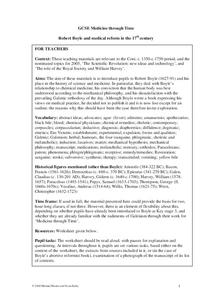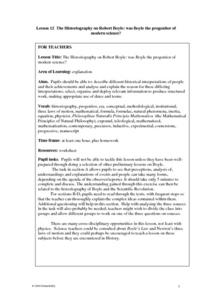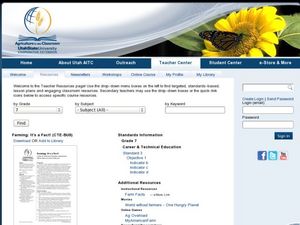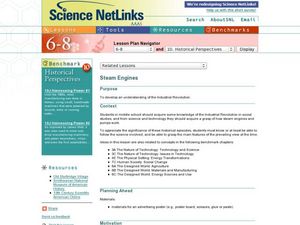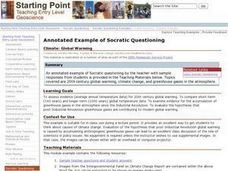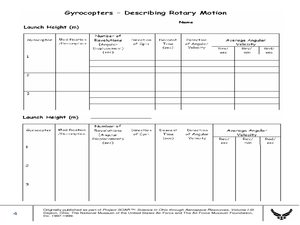Curated OER
Galileo and the Inevitability of Ideas
Learners research Galileo's work and contributions to science. They make a timeline of Galileo's life, discuss the historical context for his book "Dialogue on the Two Chief World Systems" and examine his trial by the Inquisition for...
National Nanotechnology Infrastructure Network
Creating and Testing Silver-Nanoparticle Socks
Antibacterial socks are a product of nanotechnology. An inquiry-based instructional activity asks collaborative groups to create their own antibacterial socks and then test them against other products on the market. The sock with the...
Michael Hunter and Fiona Kisby
Robert Boyle and Medical Reform in the 17th Century
Introduce pupils to the work of Robert Boyle and his influence on medical practice through a series of informational texts and discussion questions.
Curated OER
The Historiography on Robert Boyle: Was Boyle the Progenitor of Modern Science?
Students participate in a warm-up activity by attending a football match writing an account of who won the game. They discuss how their account could differ from someone else's account of the game. They discuss how different people's...
Curated OER
Our Solar System and Seasons
Sixth graders investigate the relative diameters of planets and distances between them and the cause for seasons on Earth using the 5-E Learning Model. They appreciate the size and distances involved with objects in the real universe....
Cornell University
Fibers, Dyes, and the Environment
Nanofibers can be made through electrospinning or force spinning in order to reduce the negative impact on the environment. Pupils study the role of fibers and dye on the environment through a series of five hands-on activities. Then,...
Population Connection
The Peopling of Our Planet
How many people live on the planet, anyway? The first resource in a six-part series covers the topic of the world population. Scholars work in groups to conduct research and make population posters after learning about the global...
National Wildlife Federation
Why All the Wiggling on the Way Up? CO2 in the Atmosphere
The climate change debate, in the political arena, is currently a hot topic! Learners explore carbon dioxide levels in our atmosphere and what this means for the future in the 11th installment of 12. Through an analysis of carbon dioxide...
Curated OER
Earth in the Solar System
A three-week unit designed to be completed in an elementary level, dual-language immersion classroom, this resource includes several lessons intended to introduce young learners to the solar system, the Earth and how the Earth compares...
Kenan Fellows
The Little Stuff Can Make a Big Difference
Great things come in small packages! What better way to illustrate this point than a week-long look at nanotechnology? Earth science scholars explore water quality issues through lab activities, then research new innovations in nanotech...
Curated OER
Ptolemy vs. Copernicus
Students list differences in the diagrams of a geocentric universe and a heliocentric universe. They students describe the religious impact of this change on man's conception of the universe and man's place within it. Students describe...
Curated OER
Leonardo da Vinci: Creative Genius
Students discuss how Leonardo Da Vinci reflected the spirit of the Renaissance. They examine his achivements and explain the significance of his notebooks. They write essays on what constitutes a "rRenaissance man."
Curated OER
Benjamin Franklin - Master of Electricity The Kite Experiment and the Invention of the Lightning Rod
Students study Benjamin Franklin including who he was, what he invented and his experiment. In this inventive instructional activity students follow the steps of Ben Franklin and build a Leyden jar.
Curated OER
Farming: It's a Fact!
Students use worksheets, food items, and computer programs to learn about the path of food from the farm to their meals. In this agriculture lesson, students use a provided worksheet to learn facts about farming. They use a bag of...
Curated OER
It's a Matter of Consent: Considering a Patient's Rights.
Students create a Patient's Rights Charter after discussions of past experiments with such rights charters using the biographical posters in order to stimulate discussions on current attempts to create a Patient's Rights Charter. They...
Curated OER
Steam Engines
Students investigate the invention of the steam engine. For this technology lesson, students investigate the advancement of technology over time. They relate science and technology together.
Curated OER
Annotated Example of Socratic Questioning: Climate: Global Warming
Students compare and discuss short-term and longer-term global temperature data. They evaluate data from three sets of graphs and then participate in a structured whole class Socratic discussion on the possible causes of climate change.
Curated OER
The Earth-Sun-Moon System
Third graders construct a model of the earth-sun-moon system using students as the sun, moon, and earth. They discuss ways that time is related to the movement of the earth and moon.
Curated OER
Catching Some Rays
Sixth graders explore the tilt of Earth's axis. In this Earth lesson, 6th graders read a Greek mythology story explaining why there are seasons. Students build a sun-ray gathering tool from styrofoam, glue, thermometers, skewers, and...
Curated OER
Wind
Students build an anemometer and measure wind speed. In this wind speed lesson, students build an anemometer using the student instruction sheet. Students visit the Alaska windspeed website and look up the wind speed forecast. Students...
Curated OER
Reading Trees: Understanding Dendrochronology
Pupils examine tree-ring dating and discuss the lack of water the settlers in Jamestown faced. They create paper tree rings, simulate rain patterns, and describe the history of construction paper tree sequences.
Curated OER
Space Age Technology Comes to Earth
Students explore jobs related to agriculture. In this technology/agriculture instructional activity, students recognize the importance of natural resources and agriculture on the use of Range Rambler software. Students complete an...
Curated OER
Earth Turns? Prove It!
Students construct a pendulum using a washer and thin fishing line. In this earth science instructional activity, students simulate Earth's rotation using the pendulum bob and swivel chair. They explain how this activity proves that the...
Curated OER
Gyrocopter - Describing Rotary Motion
Students calculate angular displacement, velocity and acceleration of gyrocopters. In this physics lesson plan, students compare data taken from 3 different gyrocopters. They explain how differences in construction material affect...
Other popular searches
- The Scientific Revolution
- First Scientific Revolution
- Scientific Revolution Video
- Causes Scientific Revolution
- Galileo Scientific Revolution




